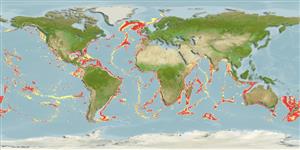Preferred temperature (Ref.
123201): 2.5 - 8.8, mean 5.3 °C (based on 1006 cells).
Phylogenetic diversity index (Ref.
82804): PD
50 = 0.5156 [Uniqueness, from 0.5 = low to 2.0 = high].
Bayesian length-weight: a=0.00087 (0.00033 - 0.00229), b=3.07 (2.84 - 3.30), in cm total length, based on LWR estimates for this (Sub)family-body shape (Ref.
93245).
Trophic level (Ref.
69278): 3.2 ±0.34 se; based on food items.
Widerstandsfähigkeit (Ref.
120179): niedrig, Verdopplung der Population dauert 4,5 - 14 Jahre. (Assuming tmax>10).
Fishing Vulnerability (Ref.
59153): Moderate vulnerability (40 of 100).
Nutrients (Ref.
124155): Calcium = 11.6 [3.1, 41.9] mg/100g; Iron = 0.349 [0.115, 0.893] mg/100g; Protein = 1.57 [0.00, 5.42] %; Omega3 = 0.309 [0.115, 0.819] g/100g; Selenium = 19.8 [5.9, 73.7] μg/100g; VitaminA = 12.1 [2.3, 60.7] μg/100g; Zinc = 0.424 [0.219, 0.870] mg/100g (wet weight);
